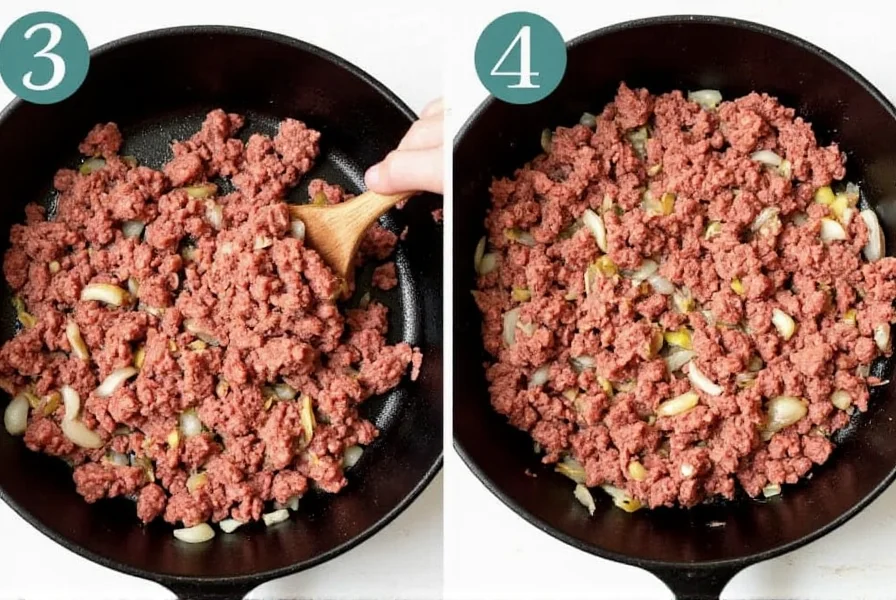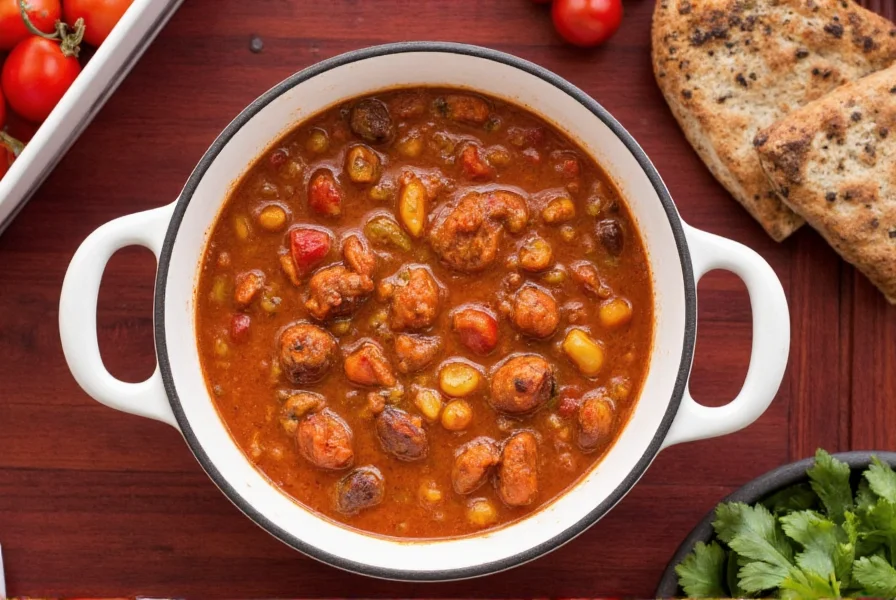Creating a rich, flavorful chili doesn't require professional cooking skills—just the right technique and quality ingredients. Whether you're cooking for a weeknight dinner or a game day gathering, this straightforward approach delivers consistent results that satisfy both beginners and experienced cooks.
Essential Ingredients for Homemade Chili
Quality ingredients form the foundation of exceptional chili. While regional variations exist, this classic recipe balances traditional elements with approachable ingredients:
| Ingredient | Quantity | Why It Matters |
|---|---|---|
| Ground beef (80% lean) | 1 pound | Provides rich meaty flavor without excessive grease |
| Yellow onion | 1 medium, finely diced | Adds sweetness and depth when properly caramelized |
| Garlic cloves | 3, minced | Essential aromatic base for complex flavor |
| Chili powder | 2 tablespoons | Core seasoning blend that defines chili's character |
| Ground cumin | 1 tablespoon | Adds earthy warmth that complements chili powder |
| Canned kidney beans | 1 (15oz) can, drained | Provides texture and protein balance |
| Canned black beans | 1 (15oz) can, drained | Adds additional texture and nutritional value |
| Diced tomatoes | 1 (28oz) can with juices | Creates the perfect liquid base with natural acidity |
| Beef broth | 1 cup | Enhances meaty flavor without overpowering |

Equipment You'll Need
While specialized equipment isn't necessary, having these basic kitchen tools makes the process smoother:
- Large heavy-bottomed pot or Dutch oven (5-6 quart capacity)
- Wooden spoon or heat-resistant spatula
- Sharp chef's knife and cutting board
- Can opener
- Measuring spoons and cups
Step-by-Step Instructions for Perfect Chili
- Brown the meat properly: Heat 1 tablespoon of oil in your pot over medium-high heat. Add the ground beef, breaking it into small pieces with your spoon. Cook until well-browned (not just grayed), about 8-10 minutes. Proper browning creates fond (those browned bits on the bottom) which adds tremendous flavor.
- Sauté aromatics: Add the diced onion to the browned meat and cook until translucent (about 5 minutes). Stir in the minced garlic and cook for 1 minute until fragrant—be careful not to burn it.
- Bloom the spices: Add chili powder, cumin, 1 teaspoon salt, and ½ teaspoon black pepper. Stir constantly for 1 minute to toast the spices, which dramatically enhances their flavor.
- Add remaining ingredients: Pour in diced tomatoes with their juice, both types of beans, and beef broth. Stir well to combine.
- Simmer for flavor development: Reduce heat to low, cover partially, and simmer for at least 30 minutes (1 hour is ideal). The longer it simmers, the more the flavors meld together. Stir occasionally.
- Adjust seasoning: Before serving, taste and adjust salt, pepper, or additional spices as needed. For more complexity, add 1 tablespoon of apple cider vinegar or lime juice.
Pro Tips for the Best Chili Experience
These professional techniques transform good chili into exceptional chili:
- Don't rush the meat browning: Taking time to properly brown the beef creates Maillard reaction compounds that add depth of flavor you can't get any other way.
- Toast your spices: Adding spices directly to the hot meat and aromatics for 60 seconds before adding liquids unlocks their essential oils and intensifies flavor.
- Balance acidity: If your chili tastes flat, add 1-2 teaspoons of vinegar or citrus juice to brighten the flavors.
- Cooling improves flavor: Chili often tastes better the next day as flavors continue to meld. Make it ahead when possible.
- Thicken if necessary: If your chili is too thin, remove the lid during the last 15-20 minutes of cooking to allow evaporation, or mash some beans against the side of the pot.
Customization Options for Different Preferences
One of the beauties of chili is its adaptability. Try these variations based on dietary needs or preferences:
- Vegetarian chili: Omit beef and use 2 cups of cooked lentils plus an additional can of beans. Substitute vegetable broth for beef broth.
- Texas-style chili: Omit beans and tomatoes, use only meat (traditionally chuck roast, cubed and browned), and increase chili powder to 3 tablespoons.
- Spicier version: Add 1-2 diced jalapeños with the onions, or include ½ teaspoon cayenne pepper with the spices.
- Milder version: Reduce chili powder to 1½ tablespoons and add 1 tablespoon of smoked paprika for flavor without heat.
- Slow cooker method: After browning meat and sautéing aromatics, transfer everything to a slow cooker and cook on low for 6-8 hours.
Serving Suggestions That Elevate Your Chili
How you serve chili significantly impacts the overall experience:
- Top with fresh ingredients like diced red onion, cilantro, or scallions for brightness
- Add creamy elements such as sour cream, Greek yogurt, or shredded cheese to balance heat
- Serve with cornbread, saltine crackers, or rice for texture contrast
- Offer lime wedges on the side for guests to add acidity as desired
- For meal prep, portion into individual containers with toppings stored separately

Storage and Reheating Guidelines
Chili stores exceptionally well, making it perfect for meal prep:
- Refrigeration: Store in airtight containers for up to 4 days
- Freezing: Portion into freezer-safe containers for up to 3 months (leave ½ inch headspace)
- Reheating on stove: Warm over medium-low heat, stirring occasionally, until heated through
- Reheating in microwave: Cover and heat in 90-second intervals, stirring between
- Reviving frozen chili: Thaw overnight in refrigerator before reheating, or defrost in microwave
Frequently Asked Questions
- How long should I simmer chili for optimal flavor?
For best results, simmer chili for at least 30 minutes, though 60-90 minutes yields significantly better flavor development. The extended cooking time allows flavors to meld and deepen. Many chili enthusiasts find that making it a day ahead and reheating improves the taste even more. - Can I make chili without beans?
Yes, you can absolutely make chili without beans. Traditional Texas-style chili omits beans entirely, focusing instead on meat, chili peppers, and spices. If you prefer beanless chili, simply increase the meat quantity by ½ pound and add an extra ½ cup of broth to maintain the proper consistency. - What's the difference between chili powder and chili seasoning?
Chili powder is primarily ground dried chilies with minimal additives, while chili seasoning typically contains chili powder plus additional spices like cumin, garlic powder, and oregano, often with salt and sugar. For better control of flavors, use pure chili powder and add individual spices separately. - How can I fix chili that's too spicy?
If your chili is too spicy, add dairy products like sour cream or shredded cheese which contain casein that counteracts capsaicin. You can also add more beans, tomatoes, or broth to dilute the heat, or include a small amount of sugar or honey to balance the spiciness. Adding a squeeze of lime juice often helps mellow excessive heat as well. - Is it better to use ground beef or cubed meat for chili?
Both work well but create different textures. Ground beef integrates throughout the chili for consistent meatiness, while cubed chuck roast (common in Texas chili) provides tender chunks of meat after slow cooking. Ground beef is quicker and more accessible for weeknight cooking, while cubed meat requires longer cooking but offers a more substantial texture.











 浙公网安备
33010002000092号
浙公网安备
33010002000092号 浙B2-20120091-4
浙B2-20120091-4